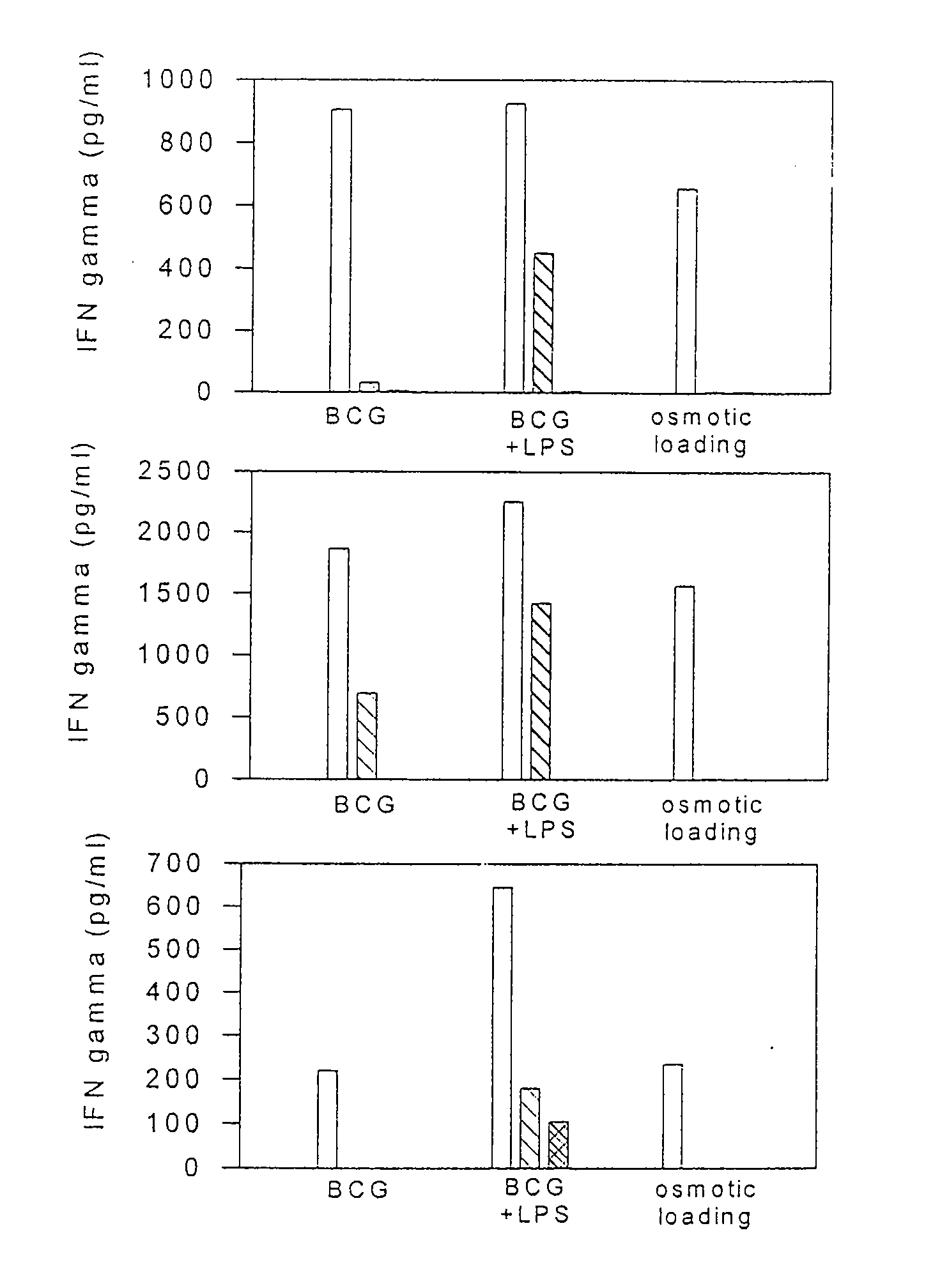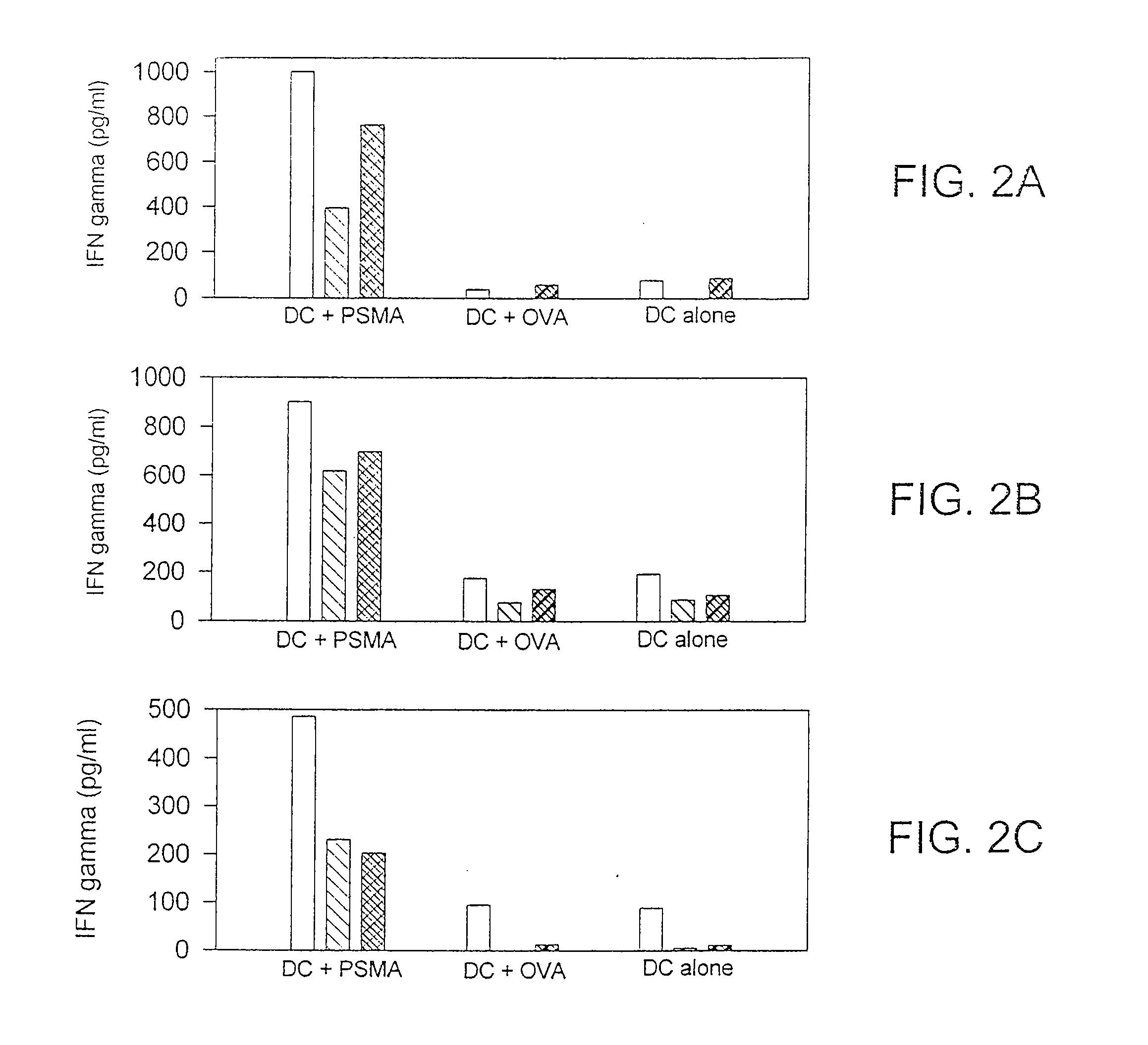Method to increase class i presentation of exogenous antigens by human dendritic cells
a human dendritic cell and exogenous technology, applied in the field of human dendritic cell class i presentation, can solve the problems of overcoming this natural immunity, inducing apcs, and often growing tumors, and achieve the effect of enhancing an existing immune response and enhancing mhc-class i processing
- Summary
- Abstract
- Description
- Claims
- Application Information
AI Technical Summary
Benefits of technology
Problems solved by technology
Method used
Image
Examples
example 1
[0098]The following example describes the isolation and culturing of human dendritic cells. Isolated dendritic cells were contacted with tumor cell lysate, and partially purified tumor cell lysate in combination with BCG to demonstrate the stimulation of antigen-specific cytotoxic T cell response.
Culture of Patient Dendritic Cells
[0099]Cultures of human DCs were established as described previously herein and in U.S. Pat. No. 5,788,963 (incorporated herein by reference). Briefly, peripheral blood mononuclear cells (PBMC) were obtained from leukocyte-enriched “buffy coats” by standard centrifugation on Ficoll-Paque (Pharmacia, Uppsala, Sweden). Plastic-adherent PBMCs (about 1 hour at 37° C.) were cultured for 6 to 7 days in AIM-V either supplemented or not with 2% autologous serum, 50 U / ml penicillin, 50 μg / ml streptomycin, 2 mM L-glutamine, 10 mM HEPES, 0.1 mM non-essential amino acids, and 1 mM pyruvate (referred to as “culture medium”; all from Boehringer Ingelheim, Biowhittaker, V...
example 2
[0109]The present example examines whether dendritic cells retain their function after cryopreservation. This characteristic is particularly important because immunotherapy approaches involve multiple treatments and it is preferable that all the DCs for each patient be prepared and loaded with antigen during a single preparation, then aliquoted and cryopreserved for subsequent infusion. It was possible that the freezing and thawing of the DCs may limit their effectiveness as CD8+ T cell activators.
[0110]Dendritic cells were isolated from PBMC of a prostate cancer patient and cultured, as described above, for 7 days in the presence of 500 U / ml GM-CSF and 500 U / ml IL-4. On day 7, the isolated DC's were harvested and cryopreserved using 90% fetal calf serum and 10% dimethylsulfoxide. The cryopreserved DC's were subsequently stored frozen for a period of time, thawed in a 37° C. water bath and transferred to a 15 ml polypropylene tube and centrifuged at 1200 rpm for 5 min. The thawed DC...
example 3
[0113]In this example dendritic cells isolated from a cancer patient were isolated and treated with various concentrations of BCG. After several days of culture, the DCs were tested for 1) the capacity to uptake particles by pinocytosis, and 2) the surface expression of certain dendritic cell maturation markers, including HLA-DR, CD86, CD40, CD83, CD80 and HLA-class I.
[0114]Dendritic cells were isolated from patient 57 as described above. The isolated cells (1-5×106) were cultured for about 6 days in eight T-75 flasks. BCG (1×106 units / ml) was added to duplicate flasks to achieve a dilution of 1:250, 1:2,500, or 1:25,000. No BCG was added to the two remaining culture flasks. A first set of culture flasks comprising DCs with no BCG, or with 1:250; 1:2,500: or 1:25,000 BCG dilution was harvested after a 48 or 72 hour incubation. The duplicate set of culture flasks was harvested after a total of 72 hours in culture. Each DC culture was analyzed for: (1) the capacity to uptake FITC / Dext...
PUM
 Login to View More
Login to View More Abstract
Description
Claims
Application Information
 Login to View More
Login to View More - R&D
- Intellectual Property
- Life Sciences
- Materials
- Tech Scout
- Unparalleled Data Quality
- Higher Quality Content
- 60% Fewer Hallucinations
Browse by: Latest US Patents, China's latest patents, Technical Efficacy Thesaurus, Application Domain, Technology Topic, Popular Technical Reports.
© 2025 PatSnap. All rights reserved.Legal|Privacy policy|Modern Slavery Act Transparency Statement|Sitemap|About US| Contact US: help@patsnap.com



